
Nasi lemak is a dish originating in Malay cuisine that consists of fragrant rice cooked in coconut milk and pandan leaf. It is commonly found in Malaysia, where it is considered the national dish. It is also the native dish in neighbouring areas with significant Malay populations such as Singapore, Brunei, and Southern Thailand. In Indonesia it can be found in several parts of Sumatra, especially the Malay regions of Riau, Riau Islands and Medan. Nasi lemak can also be found in the Bangsamoro region of Mindanao, prepared by Filipino Moros, as well as Australia's external territories of Christmas Island and the Cocos (Keeling) Islands. It is considered an essential dish for a typical Malay-style breakfast. Nasi lemak is featured as a national dish in most of the country’s tourism brochures and promotional materials.

Malay cuisine is the traditional food of the ethnic Malays of Southeast Asia, residing in modern-day Malaysia, Indonesia, Singapore, Brunei, Southern Thailand and the Philippines as well as Cocos Islands, Christmas Island, Sri Lanka and South Africa.

Fried rice is a dish of cooked rice that has been stir-fried in a wok or a frying pan and is usually mixed with other ingredients such as eggs, vegetables, seafood, or meat. It is often eaten by itself or as an accompaniment to another dish. Fried rice is a popular component of East Asian, Southeast Asian and certain South Asian cuisines, as well as a staple national dish of Indonesia. As a homemade dish, fried rice is typically made with ingredients left over from other dishes, leading to countless variations. Fried rice first developed during the Sui Dynasty in China and as such all fried rice dishes can trace their origins to Chinese fried rice.
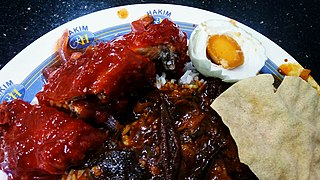
Nasi kandar is a popular northern Malaysian dish, which originates from Penang. It was popularized by Tamil Muslim traders from India. It is a meal of steamed rice which can be plain or mildly flavored, and served with a variety of curries and side dishes.

Nasi uduk is an Indonesian style steamed rice cooked in coconut milk dish, which originated from Java. It was the brainchild of Sultan Agung of Mataram, inspired by his experience eating kebuli rice.
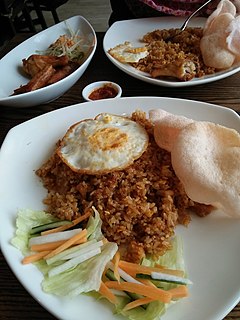
Nasi goreng is a Southeast Asian fried rice dish, usually cooked with pieces of meat and vegetables. One of Indonesia's national dishes, it is also endemic in Malay-speaking communities in countries such as Malaysia, Singapore and Brunei, and has gained popularity in Sri Lanka through migrations from the Malay Archipelago, in countries like Suriname via Indonesian immigrant communities, and in the Netherlands through its colonial ties with Indonesia. Nasi goreng is distinguished from other Asian fried rice preparations by its distinct smoky aroma, and caramelised yet savoury undertones of flavour. There is no single defined recipe for nasi goreng, and its composition and preparation varies greatly from household to household.
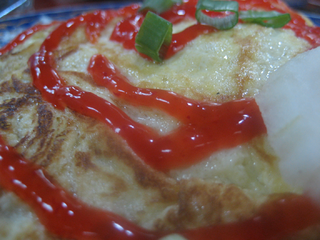
Nasi goreng pattaya, or simply nasi pattaya, is a Southeast Asian fried rice dish made by covering or wrapping chicken fried rice, in thin fried egg or omelette. Despite its name, the dish is believed to originate from Malaysia, and today is also commonly found in Indonesia and Singapore. It is often served with chili sauce, tomato ketchup, slices of cucumber, and keropok.
Nasi pad prik is a Malaysian dish of fried rice flavoured with sauteed chilli paste. Nasi is Malay for rice and pad prik is a Thai phrase ผัดพริก where pad means stirfry and prik means chili. Although Nasi Pad Prik today is regarded as part of Malay cuisine, it is Thai in origin.

Nasi kuning, or sometimes called nasi kunyit, is an Indonesian fragrant rice dish cooked with coconut milk and turmeric, hence the name nasi kuning.
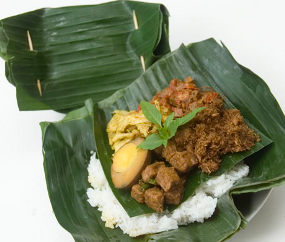
Nasi bogana or nasi begana, pronounced as nah-see boh-gâna, is an Indonesian style rice dish, originally from Tegal, Central Java. It is usually wrapped in banana leaves and served with side dishes.

Nasi bakar refer to steamed rice seasoned with spices and ingredients and wrapped in banana leaf secured with lidi semat and later grilled upon charcoal fire. The burned banana leaf produced a unique aroma upon the rice. The banana leaf package is opened upon consumption. It is a relatively newly developed Indonesian dish around the early 2000s, probably derived from nasi timbel rice wrapped in banana leaf. (Source?)

Nasi timbel is an Indonesian hot dish, consisting of steamed rice wrapped inside a banana leaf. It is a traditional Sundanese cuisine from West Java. The heat of the hot-cooked rice touches the banana leaf and produces a unique aroma. It is made in ways similar to making lontong; compressed, rolled, and wrapped in banana leaves; it then evolves into a complete dish served with various side dishes such as fried chicken, empal gepuk, jambal roti, tahu goreng, tempeh, salted duck egg, sayur asem, with lalab and sambal. Nasi timbel later evolved to nasi bakar.

Nasi kapau is a Minangkabau steamed rice topped with various choices of dishes originated from Nagari Kapau, Bukittinggi, a tourism and culinary hotspot town in West Sumatra, Indonesia. It is often describes as Minang version of nasi ramas or nasi campur.

Nasi padang, more commonly referred to as Padang rice, is a Minangkabau steamed rice served with various choices of pre-cooked dishes originating from West Sumatra, Indonesia. It is named after the city Padang, capital of West Sumatra province. A miniature banquet of meats, fish, vegetables, and spicy sambals eaten with plain white rice, it is Sumatra's most famous export and the Minangkabau people's primary contribution to Indonesian cuisine.

Betawi cuisine is rich, diverse and eclectic, in part because the Betawi people that create them were composed from numbers of regional immigrants that came from various places in the Indonesian archipelago, as well as Chinese, Indian, Arab, and European traders, visitors and immigrants that were attracted to the port city of Batavia since centuries ago.
Nasi gurih is an Indonesian steamed rice cooked in coconut milk and spices dish originally from Aceh, Indonesia.

Nasi campur, also known as nasi rames or ꦱꦼꦒꦕꦩ꧀ꦥꦸꦂ [sə'gɔ ˈtʃampur] in Java, refers to an Indonesian dish of a scoop of nasi putih accompanied by small portions of a number of other dishes, which includes meats, vegetables, peanuts, eggs, and fried-shrimp krupuk. Depending on origin, a nasi campur vendor might serve several side dishes, including vegetables, fish, and meats. It is a staple meal from Indonesia and popular in Malaysia, Singapore, Brunei, and southern Thailand, and also the Netherlands through its colonial ties with Indonesia. A similar form called chanpurū exists in Okinawa.

Nasi tutug oncom or sometimes simply called tutug oncom, is an Indonesian style rice dish, made of rice mixed with oncom fermented beans, originally from Tasikmalaya, West Java. It is usually wrapped in banana leaves and served with various side dishes.

Arab Indonesian cuisine is characterized by the mixture of Middle Eastern cuisine with local Indonesian-style. Arab Indonesians brought their legacy of Arab cuisine—originally from Hadhramaut, Hejaz and Egypt—and modified some of the dishes with the addition of Indonesian ingredients. The Arabs arrived in the Nusantara archipelago to trade and spread Islam. In Java, since the 18th century AD, most of Arab traders settled on the north coast and diffuse with indigenous, thus affecting the local cuisine culture, especially in the use of mutton meat and ghee in cooking.
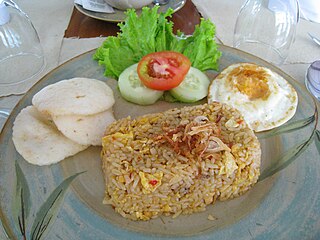
Nasi goreng jawa is a Javanese-style of fried rice originated from Java. This dish can be found in Javanese cuisine and quite popular in Indonesia, especially Java. Commonly, this rice dish uses sambal ulek as seasoning and has a spicy taste.
















